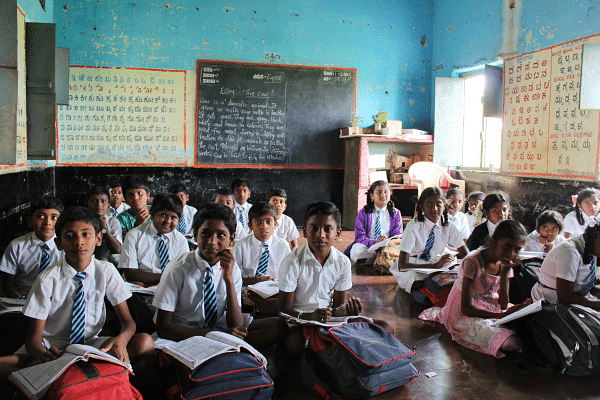
Is Indian Education Sector Prepared For EWS Quota?
The government must ensure that the rise in the number of educational institutions along with a rise in student strength because of the different kinds of quotas must not be a deterrent to providing quality higher education.
In industry-academia meetings, I often hear different versions of this remark: “Our youth are employable but not deployable. They are qualified but not educated.”
What does this statement mean?
To put it simply, it means that we are continuously producing manpower that is qualified, armed with good academic credentials, but who cannot be put to work without further training or skilling.
In the past few years, this gap has been recognised by the government and enough emphasis is being given to raise the quality of education as well as that of skill development. The government has shown a commitment to improve the overall quality of education and it is still a work in progress.
The vision has been to realise the full potential of India’s human resources in the education sector with equity and inclusion. Several initiatives like Impacting Research Innovation and Technology (IMPRINT), Global Initiative of Academic Networks (GIAN), Higher Education Financing Agency (HEFA), and National Academic Depository (NAD) are aimed at promoting quality education, and the government deserves credit for it.
Recently, another variable was added in the education sector, and that has come in the form of reservation for the economically weaker classes. The 10 per cent reservation is undoubtedly a bold move, and has been supported by most of the political parties. Such a quota will reserve better opportunities for those who belong to economically backward classes, a part of the society that was not considered to be a social unit by itself.
It would also help in cooling off the sentiment among some upper class yet economically backward groups who feel disadvantaged. But, while everybody is lauding or questioning the intent of the government initiative, it is also necessary to draw attention to the timing of the announcement and the preparedness of the sector to execute the proposed changes.
There have been efforts made in the past five years to elevate the standard of the Indian education system so as to bring it to the level of the world’s premier educational organisations, but unfortunately, this additional reservation could have an adverse impact on the overall endeavour.
Let us take an example. Suppose an educational institute had 800 seats before the implementation of this reservation drive. Introduction of the 10 per cent quota will mean increasing the seats by 25 per cent so that the existing opportunities for other classes are not compromised (as per the Supreme Court ruling). So, then, the institute will now have to offer admission to a 1,000 seats. This addition of seats will require infrastructure improvements, including more classrooms, faculty, support staff, and so on.
Now let us consider the addition to faculty strength required in such a situation. In the recent past, the All India Council for Technical Education (AICTE) has relaxed the student-faculty ratio from 15:1 to 20:1 in technical education. In the university system, it is already close to 20:1 (Nearly 21:1 as per the India Survey on Higher Education – MHRD 2015-16 report). So, if the required faculty strength earlier was 40 (for 800 students), now the required faculty strength would be 50 (for 1,000 students).
At this point, it must be emphasised that there is already a 35-40 per cent faculty crunch in higher education (widely reported and discussed in various media reports). This additional faculty requirement is likely to increase the faculty shortage to about 50 per cent approximately. That means nearly half of the faculty positions will be unoccupied!
This is the situation without even accounting for the additional non-teaching staff requirement. Additionally, there will also be structural enhancements that need to be accounted for. When is the government going to fill this gap? The decision has to be made rather quickly.
What Must Be Done?
Recall that after the Indian Institutes of Technology (IITs) did it, 31 National Institutes of Technology (NITs) and some other educational institutes have already rolled out a 14 per cent supernumerary quota for girls, resulting in the rise in total student strength. That has already burdened the existing infrastructure of the prevailing system.
It is important to note, also, that the government is already considering the seriousness of the issue and preparing to provide additional financial grant, so as to deal with the critical situation. Now, it will depend on the education administrators and bureaucrats to take quick measures to develop a comprehensive education infrastructure.
Undoubtedly, if timely steps are not taken to develop the infrastructure for this continuously increasing student strength, even a well-intended move like reservation for the economically weaker sections might backfire. It will lead to a compromise in the quality of education, further leading to substandard skilled manpower who are unable to meet global demands. In the game of quality versus quantity, the government will have to optimise well before it’s too late.
I hope the Indian experience will help going forward. Reservation was provided as a short-term remedy to substantially help the socially downtrodden class of people. It should be remembered that reservation is best served as a short-term measure to uplift society only if we have learnt how to develop a society with equal opportunity in the long term.
Institutions of higher education should not become factories to produce more and more manpower. Rather, these should produce scholars, artists, scientists, i.e., talented men and women across fields, primarily in the interest of the nation and mankind.
The government must ensure that the rise in the number of educational institutions along with a rise in student strength because of the different kinds of quotas must not be a deterrent to providing quality higher education and to make our nation “vishwa guru” or world leader, as envisioned by the honorable prime minister.